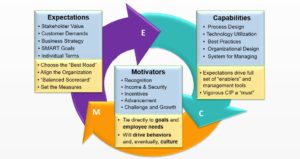In my last post on mission-driven leadership, I wrote about how organizational leaders must administer quantitative accountability and embody the needs of those they lead. They hold managers accountable for addressing employees’ needs, helping to maximize employee engagement.
In this post, I’m writing about the second part of that equation: How managers play a critical role in mission-driven leadership, too, serving both the interests of the organization’s leader and the enterprise as a whole.
Among their varied competencies and experience levels, our managers are selected because of their leadership skills. In the Brooks International context, our managers are responsible for translating the application of the Brooks International methodology to their teams and driving the achievement of quantifiable business outcomes for our clients, and ultimately for our firm.

In the client context, managers must lead our engagement teams to instill commitment in client management to motivate the company’s employees to achieve line-level objectives and business outcomes (our clients’ strategic imperatives). Managers continuously align daily operations with the company’s mission, and encourage understanding and passion for that mission and the company’s purpose, among all employees.
According to recent research, mission-driven/purpose-oriented employees are 54% more likely to stay at a company for more than five years and 30% more likely to be high performers. Employees who understand and are aligned with their companies’ missions are more productive, loyal and cost the company less over the long term.
Managers must not only understand why their company exists (the company’s mission) but also what the company wants to achieve, pushing and leading their employees toward the desired results.
It’s been found that having a strong corporate mission increases corporate confidence, innovation, talent acquisition, employee engagement and trust, and high-trust companies are two and a half times more likely to be high-performing organizations in revenue growth than low-performing companies.
Another recent study found that 81% of respondents working for organizations with a strong sense of mission say their stakeholders trust their leadership team, versus 54% for those without a strong purpose. In a separate survey, 73 percent of employees who said they worked at a purpose-driven company were engaged, compared to just 23 percent of those who didn’t.
It’s imperative for managers to actively involve client management and employees to achieve business goals aligned to the client’s mission. A well-crafted mission statement that contains both the how and the why enables managers to focus their employees through a shared understanding and acceptance of that mission.
So what is it that our managers must go do in terms of mission-driven leadership?
In our Stage II Implementation engagements, Brooks International managers actively engage staff and manage the project using Brooks International project management methods. They drive performance to the client’s mission and ensure the achievement of the client’s strategic imperative, achieving predictable business performance, sustainability and the desired/required economic value.
Managers work with their teams to develop client infrastructure accountabilities and goals, with a linkage to the HR performance management system. According to Edgar Schein, an expert in the field of organizational development and former professor at MIT’s Sloan School of Management, “All groups and organizations need to know how they are doing against their goals and periodically need to check to determine whether they are performing in line with their mission.”
Managers lead the development of the operating model design and drive the translation and cascading of goals into each implementation area. This is accomplished under the direction of the account director and in collaboration with the organizational development specialist. The result is the implementation of a robust operating model and performance review processes that deliver on-time benefit achievement that meets or exceeds the client’s expectations.
The Brooks International manager leverages the Execution Excellence model when utilizing the E-C-M methodology to apply mission deployment and role clarity.

Our approach links directly to existing HR performance management elements, emphasizing role clarity and alignment to the mission through our process, which includes confirming the client’s mission, goals and core strategies, documenting primary responsibilities for each role, and creating scorecards for each role linked to the client’s HR performance management system, among other things.
The goals are typically comprised of core strategies relating to safety, employee satisfaction, customer service, financial performance and quality. For example, if one of the client’s goals is to develop employees, our job is to provide clear roles, processes, decision guidelines, measures and direction to know when they’ve had a “good day” and to provide client managers with the tools and coaching needed to deal effectively with employee performance.
Brooks International’s managers understand this process and recognize that it differentiates us from others in our field. It aligns the entire organization to the CEO’s goals, instilling accountability while ensuring sustainability through linkage to the performance management system.
Having a strong mission statement helps keep us focused on our goals and centered on our clients’ strategic imperatives. You can read the Brooks International mission statement here.
In my next post, I’ll conclude the series on mission-driven leadership by discussing the role of consultants and client employees.